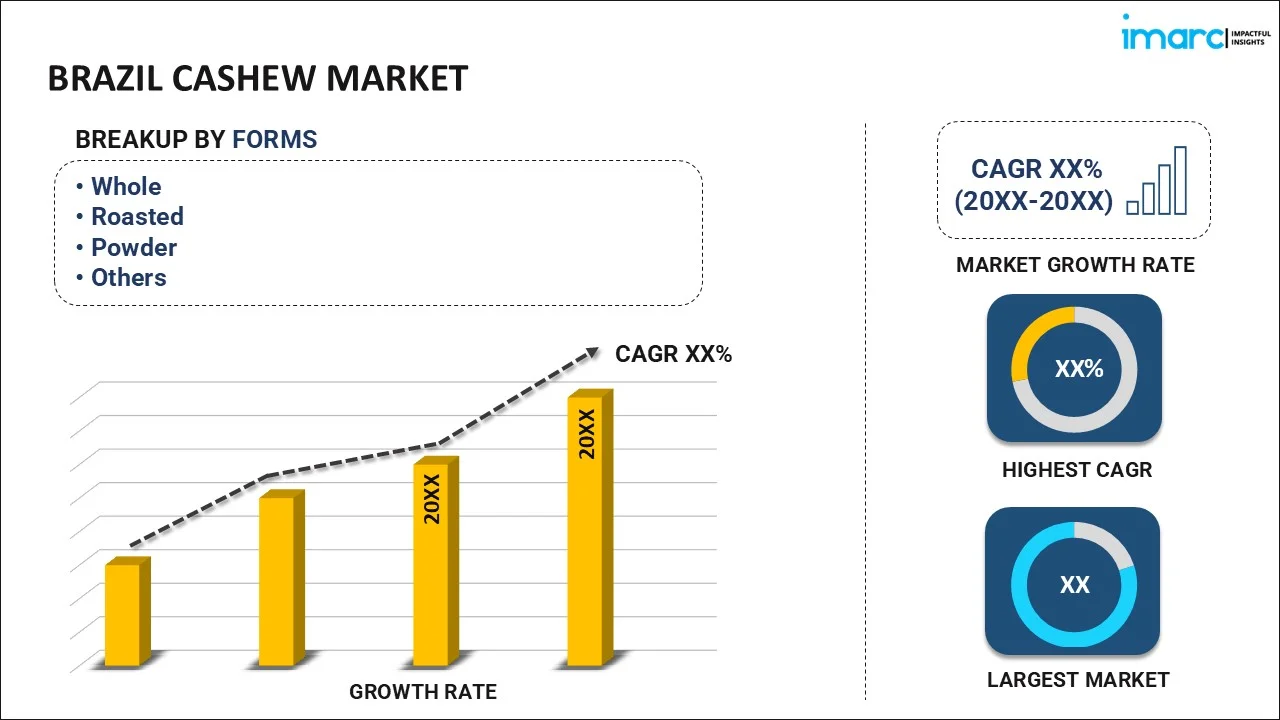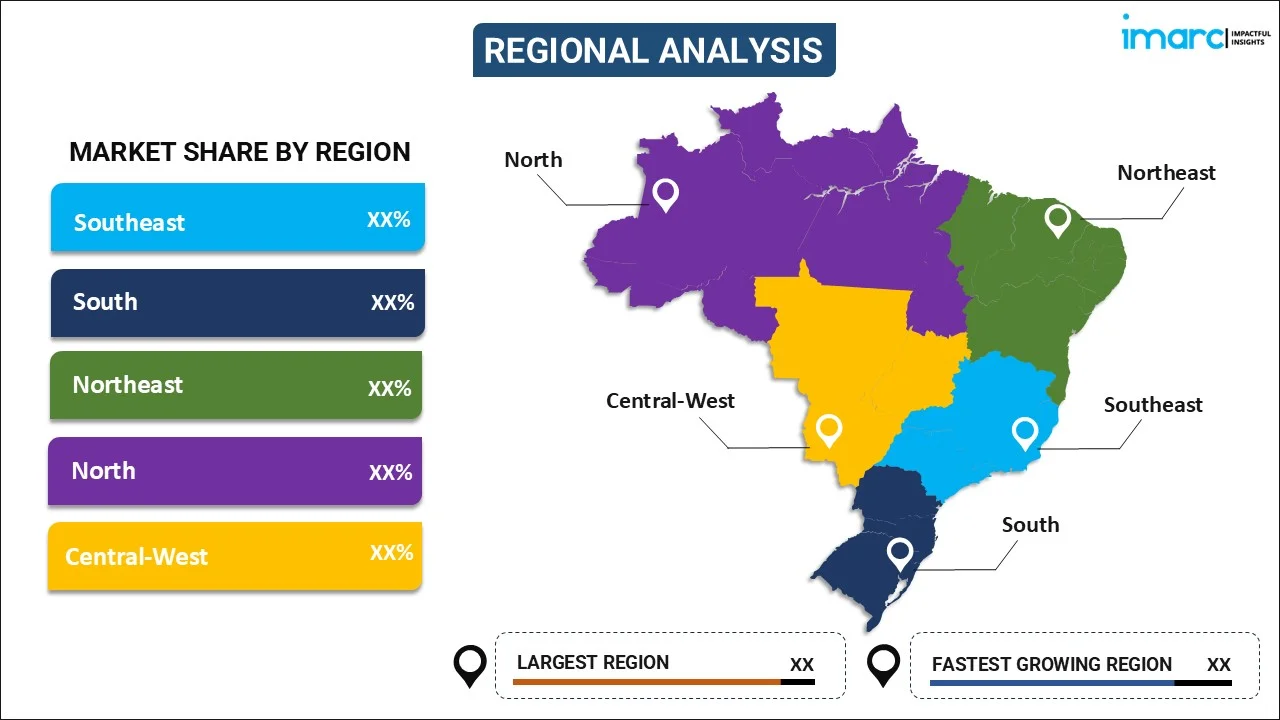
Brazil Cashew Market Size, Share, Trends and Forecast by Form, Distribution Channel, Application and Region, 2025-2033
Brazil Cashew Market Overview:
The Brazil cashew market size reached USD 0.17 Billion in 2024. Looking forward, IMARC Group expects the market to reach USD 0.23 Billion by 2033, exhibiting a growth rate (CAGR) of 3.75% during 2025-2033. The market is primarily driven by the increasing demand for healthier snack options, rising production capacity of cashews, improved government financial support, and sustainable farming practices boosting production efficiencies and market reach.
|
Report Attribute
|
Key Statistics
|
|---|---|
|
Base Year
|
2024 |
|
Forecast Years
|
2025-2033
|
|
Historical Years
|
2019-2024
|
| Market Size in 2024 | USD 0.17 Billion |
| Market Forecast in 2033 | USD 0.23 Billion |
| Market Growth Rate (2025-2033) | 3.75% |
Brazil Cashew Market Trends:
Increased Production Capacity
According to the Brazilian Institute of Geography and Statistics (IBGE), Brazil's cashew production has witnessed a sharp growth as a result of the dominant key cashew-producing states such as Ceará, which has been boosting output by making strategic upgrades in farming techniques. Secondly, the general implementation of latest agricultural methods, including precision farming and improved pest control measures, has significantly contributed to enhancing production per hectare. In addition, the use of sophisticated irrigation systems has assisted in lessening the effects of erratic rain patterns, a problem faced by most farmers in Brazil's semi-arid areas. Additionally, farmers can maintain steady cashew yields during drought seasons by enhancing water management. In addition to this, a number of investments in research and development (R&D) have also helped the growth, with new varieties of cashews being grown that are more disease-resistant and climate-tolerant. This enhanced production capability enhances Brazil's position in the international cashew market and offers greater scope for local farmers to improve their livelihoods through increased yields and better product quality.
Supportive Government Initiatives
The government of Brazil has been instrumental in promoting the development of the cashew industry through interventionist policies and strategies. The government has, over the years, introduced schemes to offer subsidies for cashew production with the aim of increasing the efficiency and sustainability of small and medium-scale farmers. According to the United States Department of Agriculture (USDA), Brazil has unveiled new figures of government-backed credit and financing for the 2024-2025 agricultural season. In addition, on 3 June 2024, Brazilian President Luís Inacio Lula da Silva declared R$ 475.5 Billion (around US$ 88.2 Billion, at prevailing exchange rates) in funding for Brazil's Crop Plan 2024-2025. This year's announcement is a notional record (in Brazilian Real [R$]) and a 9% rise from 2023-2024's R$ 435.8 Billion (US$ 80.9 Billion). Such subsidies aim at enhancing overall productivity while minimizing operation expenses, so cashew cultivation becomes feasible, particularly for smaller-scale operators. Furthermore, training programs supported by the government have been initiated to train farmers on sustainable farming methods, pest control, and proper water utilization. This assistance has enhanced productivity and promoted the use of eco-friendly farming practices. Consequently, Brazil's cashew industry is becoming stronger and competitive, with higher production adding to the development of the local economy and the nation's export capacity in the market.
Brazil Cashew Market Segmentation:
IMARC Group provides an analysis of the key trends in each segment of the market, along with forecasts at the country level for 2025-2033. Our report has categorized the market based on form, distribution channel, and application.
Form Insights:

- Whole
- Roasted
- Powder
- Paste
- Splits
The report has provided a detailed breakup and analysis of the market based on the form. This includes whole, roasted, powder, paste and splits.
Distribution Channel Insights:
- Supermarkets
- Retailers
- Online Stores
- Others
The report has provided a detailed breakup and analysis of the market based on the distribution channel. This includes supermarkets, retailers, online stores and others.
Application Insights:
- Dairy Products
- Bakery Products
- Snacks and Bars
- Confectionaries
- Cereals
- Desserts
- Beverages
- Cosmetic Products
- Others
A detailed breakup and analysis of the market based on the application have also been provided in the report. This includes dairy products, bakery products, snacks and bars, confectionaries, cereals, desserts, beverages, cosmetic products and others.
Regional Insights:

- Southeast
- South
- Northeast
- North
- Central-West
The report has also provided a comprehensive analysis of all the major regional markets, which include Southeast, South, Northeast, North and Central-West.
Competitive Landscape:
The market research report has also provided a comprehensive analysis of the competitive landscape. Competitive analysis such as market structure, key player positioning, top winning strategies, competitive dashboard, and company evaluation quadrant has been covered in the report. Also, detailed profiles of all major companies have been provided.
Brazil Cashew Market News:
- On 26 February 2024, Sao Geraldo collaborated with CANPACK Brazil to introduce its premier beverage in 350ml cans that are fully recyclable. Cajuina Sao Geraldo is a soft drink containing 5% juice extracted from the fruits of indigenous cashew trees, and it is highly favored in the northeastern regions of Brazil. The distinct taste of the beverage is derived from the cashew fruit itself.
Brazil Cashew Market Report Coverage:
| Report Features | Details |
|---|---|
| Base Year of the Analysis | 2024 |
| Historical Period | 2019-2024 |
| Forecast Period | 2025-2033 |
| Units | Billion USD |
| Scope of the Report |
Exploration of Historical Trends and Market Outlook, Industry Catalysts and Challenges, Segment-Wise Historical and Future Market Assessment:
|
| Forms Covered | Whole, Roasted, Powder, Paste, and Splits |
| Distribution Channels Covered | Supermarkets, Retailers, Online Stores, and Others |
| Applications Covered | Dairy Products, Bakery Products, Snacks and Bars, Confectionaries, Cereals, Desserts, Beverages, Cosmetic Products, and Others |
| Regions Covered | Southeast, South, Northeast, North and Central-West |
| Customization Scope | 10% Free Customization |
| Post-Sale Analyst Support | 10-12 Weeks |
| Delivery Format | PDF and Excel through Email (We can also provide the editable version of the report in PPT/Word format on special request) |
Key Questions Answered in This Report:
- How has the Brazil cashew market performed so far and how will it perform in the coming years?
- What is the breakup of the Brazil cashew market on the basis of form?
- What is the breakup of the Brazil cashew market on the basis of distribution channel?
- What is the breakup of the Brazil cashew market on the basis of application?
- What is the breakup of the Brazil cashew market on the basis of region?
- What are the various stages in the value chain of the Brazil cashew market?
- What are the key driving factors and challenges in the Brazil cashew market?
- What is the structure of the Brazil cashew market and who are the key players?
- What is the degree of competition in the Brazil cashew market?
Key Benefits for Stakeholders:
- IMARC’s industry report offers a comprehensive quantitative analysis of various market segments, historical and current market trends, market forecasts, and dynamics of the Brazil cashew market from 2019-2033.
- The research report provides the latest information on the market drivers, challenges, and opportunities in the Brazil cashew market.
- Porter's five forces analysis assist stakeholders in assessing the impact of new entrants, competitive rivalry, supplier power, buyer power, and the threat of substitution. It helps stakeholders to analyze the level of competition within the Brazil cashew industry and its attractiveness.
- Competitive landscape allows stakeholders to understand their competitive environment and provides an insight into the current positions of key players in the market.
Need more help?
- Speak to our experienced analysts for insights on the current market scenarios.
- Include additional segments and countries to customize the report as per your requirement.
- Gain an unparalleled competitive advantage in your domain by understanding how to utilize the report and positively impacting your operations and revenue.
- For further assistance, please connect with our analysts.
 Request Customization
Request Customization
 Speak to an Analyst
Speak to an Analyst
 Request Brochure
Request Brochure
 Inquire Before Buying
Inquire Before Buying




.webp)




.webp)












